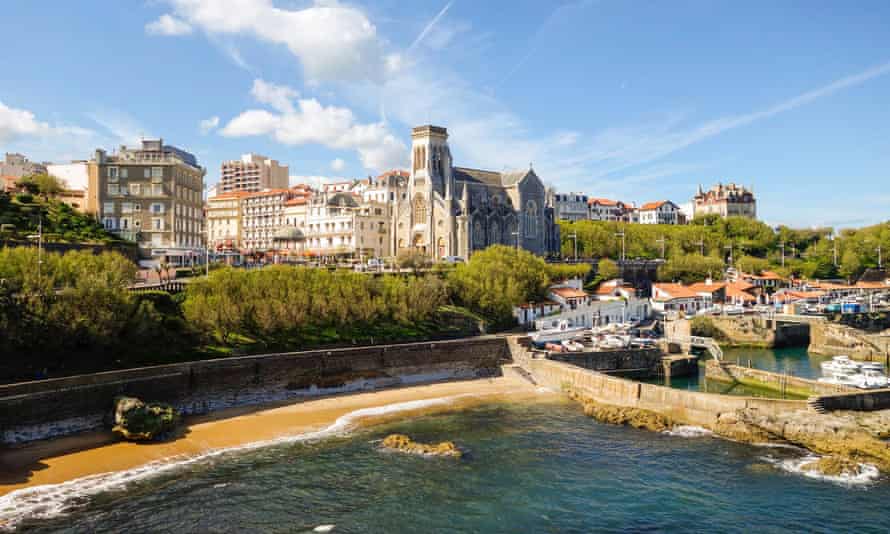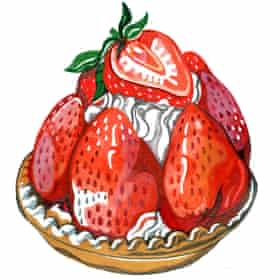Isabelle de Joantho is a painter and sculptor who studied at the Bayonne-Anglet-Biarritz School of Art.
Food
La Goulue restaurant (named after a can-can dancer at the Moulin Rouge who used to gulp down her clients’ drinks) serves great, local fare in a Basque-red 1900s dining room. I love the chipirons grillés a la plancha (squid grilled with garlic and parsley) and Spanish-style sea bream. For fresh food, Les Halles covered market is filled with tasting bars, organic bakeries, cheese and charcuterie stalls and fishmongers. Two other places not to miss are Place Bellevue on the seafront for one of Maison Pariès’ caramel fondant kanougas, flavoured with vanilla or Espelette chilli pepper. And in Bidart, a town a little way down the coast, it’s worth watching a gâteau basque (a cake with a creamy filling and orange zest) being made in front of you at the Moulin de Bassilour watermill.
Inspiration

Overlooking the old fishing port is the impressive, greystone neo-Gothic Église de Sainte-Eugénie – patron saint of Napoleon III’s wife, Eugénie de Montijo, who fashioned Biarritz as a spectacular health and holiday resort in the mid-19th century. My inspirational place lies beneath: the huge, vaulted crypt, which is used as a venue for art shows. I have exhibited there many times and it has an amazing ambiance. Biarritz is now a major hub for galleries and contemporary art, and I always attend La Brouillarta, an annual outdoor art fair on the seafront. There’s also a parcours d’oeuvres d’art, a walking route around the city’s many frescoes and outdoor sculptures.
Green space
Biarritz’s assets include the sea, the mountains, the countryside and the Spanish border, but we have three golden retrievers, so green spaces are very important to us. There are two wonderful lakes just outside the city, Lac Mouriscot and Lac Marion. Mouriscot is popular with joggers and cyclists: it has wide, wild pathways through the woods and plenty of benches overlooking the lake. Marion, which is equally good for dogs and families, has a bucolic lakeside path, some areas of marshland, plus lots of mature trees and lawns. Both can be reached on bus route 5 from the centre of town, heading past Biarritz’s horse racing track.
Neighbourhood

Biarritz’s Grande Plage and casino seafront can become very crowded in the summer, so it is best to visit out of season, but the Port des Pêcheurs to the south is always wonderful. Set on a natural creek, the protected harbour has a “village” of 65 cabins known as crampottes – whitewashed fishing huts built into the rock, with red, blue or bright green shutters. They have hardly changed in 150 years, though a few have been turned into cafes and restaurants. There is a 19-year waiting list to rent one – you have to own a boat and a mooring in the fishing port. The port sits beneath the old whale-watching tower and is the most authentic and charming stretch of the Biarritz seafront. It has a little beach, and lanes draped with floats, fishing nets and the occasional giant anchor.

Nightlife
Le Bar Jean, at the heart of Biarritz’s tapas, paella and beef-eating culture since the 1930s, stays open until well after midnight, as do many of the pintxos (tapas) bars around Les Halles market. It’s popular to go from bar to bar in Biarritz, tasting tapas with Basque cider, which is poured into tiny, round glasses from high above the table so the cider becomes aerated, though it is quite sour and vinegary! Or, if you are at the beach along the city’s Côte des Basques, it’s only 100 steps up to Bar Etxola Bibi, a great place to watch the sunset with a cocktail and plate of pintxos.
Stay
Close to the beaches and Les Halles, Villa Koegui (doubles from €85, breakfast €15pp) was renovated this year. It has a stylish lounge, an outdoor terrace and family suites.



